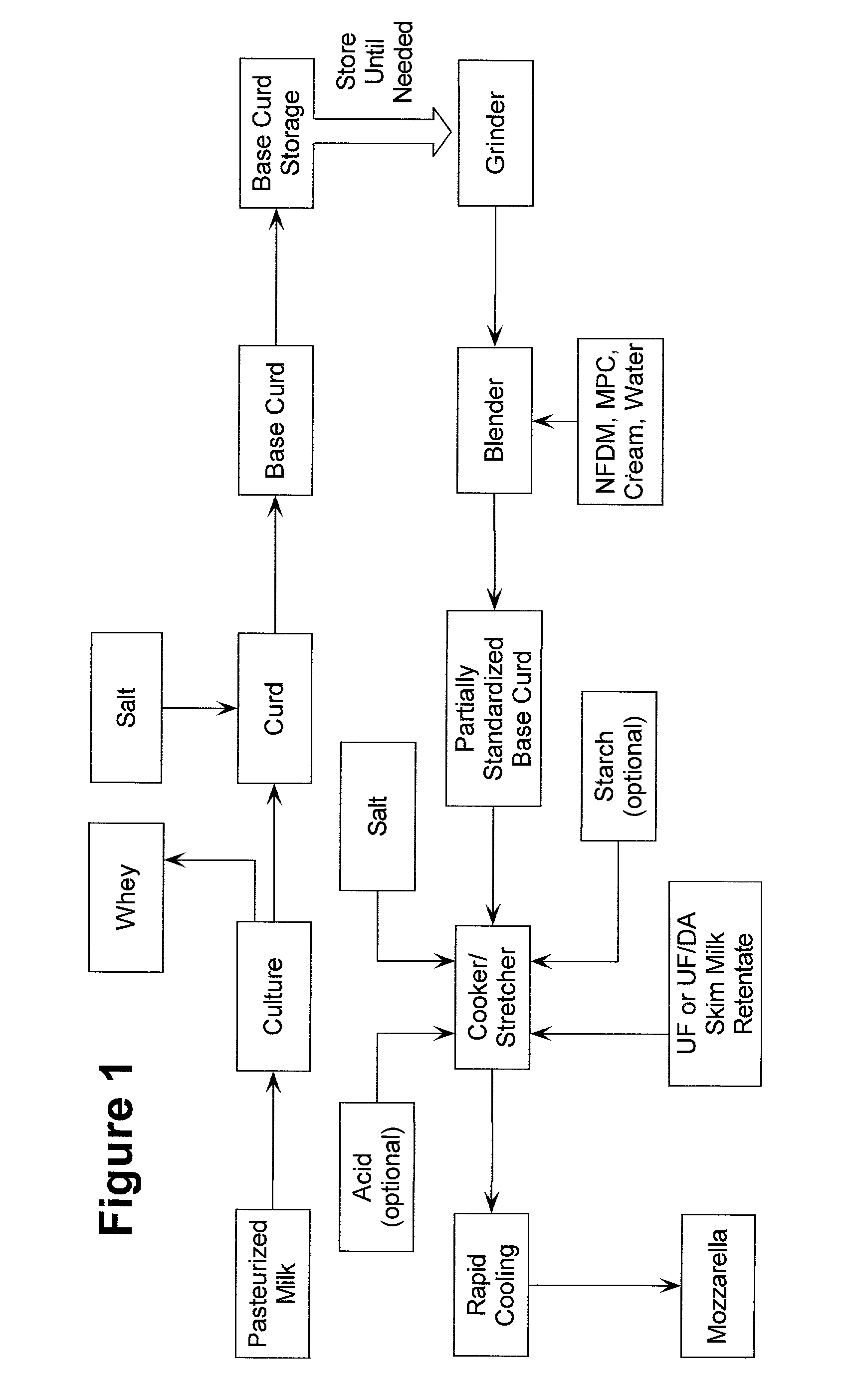Process for mozzarella cheese
a technology for processing and mozzarella cheese, which is applied in the field of cheese products, can solve the problems of microbial contamination that can occur during brine cooling, and achieve the effects of reducing the risk of microbial contamination, rapid cooling of curd, and economic use of raw materials
- Summary
- Abstract
- Description
- Claims
- Application Information
AI Technical Summary
Benefits of technology
Problems solved by technology
Method used
Image
Examples
example 1
[0032] The fluid media containing non-fat milk solids and fat was used to prepare mozzarella cheeses. Preferably the fat content ranges from about 3 to about 4 percent. The protein content ranges from about 3 to about 4 percent. The non-fat milk solids may be provided from whole milk, reconstituted dried non-fat milk solids, or skim milk. The fat may be milk fat or other suitable fat. The fat may be provided from whole milk, partially skimmed milk, or a suitable fat may be added.
[0033] Acidity was developed in the fluid media by the addition of a lactis-acid producing culture (Chris Hansen DVS) at a level of about 0.5 percent and the culture ripened for approximately about 30 minutes, to a pH of about 6.5 to about 7.0. Sufficient double strength rennet was added, and the mixture was set in about 30 minutes. The coagulum was then cut. The temperature raised to between 98 and 102.degree. F. over a period of 30 to 35 minutes. After cooking, the curd was held at temperature for 10 minut...
example 2
[0040] Mozzarella cheese was manufactured using the same procedures as outlined in Example 1, except the UF / DF skim milk retentate was not cultured prior to use. After the retentate was pasteurized, it was cooled to 45.degree. F. and transferred into tanks for storage until use. For best results, the retentate was used within 36 hours. If an adjustment to the finished product pH is desired, this can be accomplished through the addition, for example, of acetic acid (120 grain) or other suitable edible acid to the cooker / stretcher at a level of 1 to 1.4 percent of the finished product. The resulting mozzarella cheese has a composition of 50.5% moisture, 43.4 percent fat (on a dry basis), and 1.8 percent salt.
example 3
[0041] A base curd was manufactured using essentially the same procedure as outlined in Example 1. The base curd contained 53.4 percent FDB, 34.5 percent moisture, and 1.8 percent salt with a pH of 5.15. The amount of base curd employed to produce mozzarella cheese was such that it represented 60.0 percent of the finished cheese. The base curd was standardized in the blender as in Example 1 using (as a percentage of the finished product) 0.27 percent sweet cream, 1.14 percent non-fat dry milk, and 1.21 percent milk protein concentrate (New Zealand Alapro 4700 MPC). A cultured UF / DF skim milk retentate was made as outlined in Example 1. Salt, at a level of 0.23 percent of the finished product, and UF / DF skim milk retentate, at a level of 30.3 percent of the finished product, were added to the cooker / stretcher. The cheese was cooked-stretched through direct steam injection (adding 6.85 percent water to the finished product), cooled, and chilled as outlined in Example 1. The resulting ...
PUM
 Login to View More
Login to View More Abstract
Description
Claims
Application Information
 Login to View More
Login to View More - R&D
- Intellectual Property
- Life Sciences
- Materials
- Tech Scout
- Unparalleled Data Quality
- Higher Quality Content
- 60% Fewer Hallucinations
Browse by: Latest US Patents, China's latest patents, Technical Efficacy Thesaurus, Application Domain, Technology Topic, Popular Technical Reports.
© 2025 PatSnap. All rights reserved.Legal|Privacy policy|Modern Slavery Act Transparency Statement|Sitemap|About US| Contact US: help@patsnap.com

